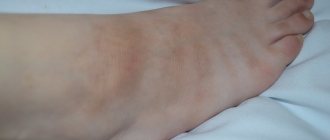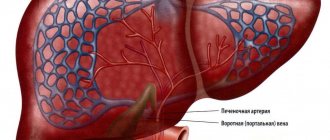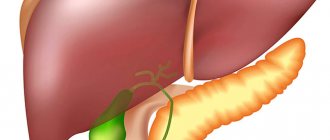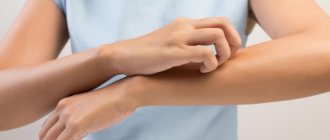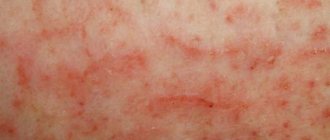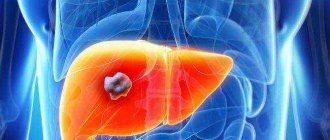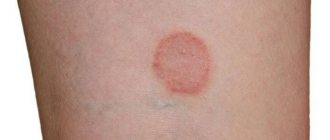It’s not for nothing that people call the liver the “filter” of our body. It performs a number of important functions, such as neutralizing toxins and other harmful substances, producing glycogen (“gasoline” for our body), and also participates in digestion, synthesizing bile, which helps absorb nutrients, break down fats, etc. Thus, thanks to the liver, we can drink and eat whatever we want in unlimited quantities.
However, everything in this world is not eternal. And our liver too. If you have an unhealthy diet, frequent consumption of alcohol, etc. the organ wears out and begins to malfunction, allowing harmful substances into the body. This is how various kinds of diseases arise that can harm a person to varying degrees, ranging from unpleasant sensations to a serious condition or even death. The skin is one of the organs that first gives signals about liver disease. And if you have a rash for no reason, you should think about whether these could be spots on the body due to liver disease?
Diseases affecting the appearance of spots on the body
The main diseases that cause redness and spots on the skin are:
- Hepatitis. Hepatitis is a disease that causes inflammation of the liver. They are usually accompanied by a variety of skin manifestations. This may include hives, changes in skin color, red-brown rashes, large pinkish-red spots, etc. The rash appears immediately after infection or during the transition to a chronic disease.
- Parasitic infections. Such diseases are divided mainly into echinococcosis, ascariasis, amoebiasis, etc., depending on the causative agent of the infection. Parasites and helminths not only damage the structure of the organ, but also stimulate neoplasms, disrupting the normal functioning of the liver. In this case, there is no jaundice, only red spots in the gland area and acne. Common symptoms are chronic fatigue, lethargy, exhaustion, sleep disturbances, bad breath, right upper quadrant pain, and enlarged liver.
- Cancer. The formation of metastases and tumors in liver cells leads to disruption of its functioning, and without treatment, to the death of a person. The development of such malignant neoplasms can be confused with other liver diseases, since their symptoms are similar: an unpleasant feeling of bloating, weakness, sometimes vomiting, loss of appetite, constant malaise. At a later stage, tumors inside the diseased organ reach such a size that they block the flow of bile into the intestines, and it goes straight into the blood. As a result, yellowing of the sclera and skin, darkening of urine, and itching occurs.
- Cirrhosis.
They are divided into: • Alcoholic; • Stagnant; • Viral. The vast majority of people get sick due to prolonged alcohol intoxication. The last two are much less common.
The main signs of cirrhosis: • Yellowness of the skin and sclera; • Itching; • Spider veins; • Yellow tongue with coating; • Acne.
- Diseases of the gallbladder and bile ducts. Cholecystitis, cholelithiasis, cholangitis are all diseases of the gallbladder. Basically, they are all associated with the formation of stones in the cavity of the bladder and its ducts.
Signs of the disease: • Itching of the epidermis; • Belching and bitterness in the mouth; • Heaviness under the right rib.
- Liver failure. This disease occurs due to an overdose of alcohol or medications, or severe poisoning. It can manifest itself in the form of yellow spots, a purulent rash, spider veins, bitterness in the mouth, and general lethargy.
Associated symptoms indicating liver disease are:
- General weakness;
- Bitterness in the mouth;
- Fatigue quickly;
- Congestive acne;
- Hair loss and brittle nails;
- Weight loss;
- Pain in the right hypochondrium;
- Feverish state;
- Dry mouth;
- Yellowness of the sclera;
- Discomfort while eating;
- Smell of overripe fruit on the breath;
- Indigestion;
- Unpleasant smell of sweat.
Diagnostic methods
Diagnosis includes taking a medical history and palpating the anterior abdominal wall to determine the size of the organ.
Vascular atherosclerosis is determined using the following anamnestic, physical, laboratory and instrumental examination methods:
- Patient interview. They find out: when the first symptoms appeared, how they developed, and what features of clinical symptoms the patient identifies.
- Palpation of the anterior abdominal wall. It can be superficial and deep. This is how they try to determine the height and nature of the surface of the edge of the liver.
- Percussion. The tapping method helps clarify the hepatic boundaries.
- Blood chemistry. With hepatocellular disorders, the level of direct and indirect bilirubin and transaminases - ALT, AST, GGT and alkaline phosphatase - increases in the blood.
- Lipidogram. Steatohepatic changes are clearly indicated by an increase in the concentration of low and very low density lipoproteins, triglycerides and cholesterol.
- Ultrasound examination of the abdominal organs. This instrumental technique allows you to determine the size of organs and the presence of tumors.
- Dopplerography of blood vessels. Visualizes vascular walls with possible atherosclerotic plaques in them.
- Computer or magnetic resonance imaging. They make it possible to carry out differential diagnosis with malignant tumors of the liver tissue.
Where do spots appear on the body due to liver disease?
With diseases of the gland, the skin becomes a non-standard color, and this should never be ignored. Yellowish skin with an orange color indicates internal liver problems; lemon tint - about hematological disorders; brown means mechanical damage to the organ.
Basically, liver spots are localized throughout the body, depending on the disease and its manifestations:
- Rash – face, neck, chest, back;
- Red spots – in the liver, abdomen;
- Yellow spots – oral cavity, sclera, with transition to other parts;
- Bright red spots – palms;
- Pigment spots – palms, arms, face, neck;
- Yellow plaques – armpits, eyelids, arms, legs, feet;
- Spider veins – neck, back, arms, face;
Each skin rash is accompanied by itching.
Reasons for the development of NAFLD
The factors influencing the development of non-alcoholic fatty disease are the same as those influencing the occurrence of atherosclerosis. The liver with atherosclerosis, its condition and functioning directly depend on this disease.
Fatty food
The causes of NAFLD and atherosclerosis are the same:
- unhealthy diet (abuse of fast foods, processed foods, fatty, fried foods);
- lack of physical activity, physical inactivity;
- overweight, obesity;
- diabetes;
- genetic predisposition.
In recent years, fat disease has become increasingly widespread, affecting not only men, but also women. On average, a quarter of the planet’s population suffers from the disease, of which a third are people of a young age category.
What do liver disease spots look like?
There are different formations.
- Spider veins. They are blood vessels that rise above the skin level. They also have branches - vascular branches. The stars are usually dark red in color. The size can reach 15 cm. The photo shows blood spots on the body due to liver disease.
Upon palpation, you can notice how the stars pulsate. Sometimes they are quite painful and do not go away throughout the illness.
- Rash. It is not uncommon for a rash to appear with such diseases. It can be pustular, acne, or papulous. The main places of its concentration are the face, neck, back and chest.
The rash can also appear as an allergic reaction. For example, this happens with parasitic infections or an overdose of medical or other substances.
- Liver plaques. Most often they are a consequence of chronic diseases. They look like traces of healed burns and have clear edges.
At the first stage, they appear as round red lumps, then develop into blisters. After their breakthrough, a whitish spot with a red border remains in this place.
- Red palms. This phenomenon occurs in chronic liver diseases. The diseased organ cannot cope with the processing of hormones, so the bloodstream mixes on the surface of the palms, which is why the limbs acquire a bright red tint.
When pressed, this disappears, but after a while the previous color appears again. Redness of the palms is often accompanied by fever and can spread to the feet.
- Purpura spots.
Outwardly, this phenomenon looks like a scattering of hemorrhagic spots. They can be either small or reach quite large sizes. Distributed throughout the body. They disappear when the disease that caused them, liver failure, is eliminated.
- Pigmentation.
Basically, pigment spots are age-related rashes, typical for people over 40. But you should pay attention to them if: • There are too many of them; • The shade of the spots changes – it becomes gray or bronze; • The spots begin to spread.
In this case, this may be a signal that the liver is not healthy. Some doctors are of the opinion that the gland's ability to process and remove toxins deteriorates, which can result in a disease such as cholestasis.
Why does atherosclerosis appear?
The main reasons for the development of the disease are considered to be poor nutrition and lifestyle, liver dysfunction (as a result of which lipid metabolism changes), heredity and poor condition of the vascular wall (decreased elasticity, various diseases).
Cholesterol is deposited on the walls of blood vessels. This substance is a lipid and plays an important role in the human body: it is part of hormones and vitamins, as well as the cell membrane.
Most of the cholesterol is produced by the liver (up to 70%), and the rest is supplied to the body through food.
In the bloodstream, this lipid is transferred from the liver to body tissues in the form of lipoproteins.
If an excessive amount of a substance accumulates in the tissues, the excess is transported by the blood to the liver and is disposed of there. Atherosclerosis develops when this process is disrupted and any disruption occurs in the transfer of cholesterol through the blood. Low-density lipoproteins (LDL) pose a great danger to humans. They are the ones who provoke the development of atherosclerosis. LDL transports cholesterol from the liver to tissues, while HDL (high-density lipoprotein) clears cells of excess cholesterol and delivers it to the liver for disposal.
Itching and itchy spots
Almost all liver diseases are accompanied by itching on the epidermis. It especially manifests itself in combination with irritation and yellowness of the skin. This happens because bilirubin, which the liver should, but cannot, neutralize, lingers in the layers of the skin, irritating it. Thus, the body begins to itch due to stagnation of bile and, as a result, the occurrence of jaundice.
All skin rashes that appear on the skin as a result of liver disease, be it hives, plaques or red spots, are not without itching. It happens that itching occurs against the background of allergies, then in order to distinguish liver irritation from allergic irritation, you need to know that hepatic irritation is not eliminated by antiallergic drugs.
Features of pathology in children
Unfortunately, liver disease can often occur in children. Symptoms in children are quite difficult to recognize. Especially when it comes to infants. After all, even the most characteristic symptom, icteric coloration, can be interpreted as a natural physiological process.
You can suspect the presence of pathology in a baby based on the following signs:
- jaundice persists for more than 2 weeks;
- weakly colored stool indicates stagnation of bile, sometimes it becomes completely discolored;
- an enlarged tummy in a baby - this sign may indicate the occurrence of liver failure.
Even if you have the slightest suspicion that your child has a problem, you should definitely contact your pediatrician.
Treatment of liver spots
The most important thing is that you should not self-medicate. If you have liver spots, you should definitely contact a specialist who will examine you and prescribe the correct treatment.
A large number of cosmetic companies offer various medications and cosmetics for removing stains. However, the problem is within you, and after some time they will return again. It is better to focus efforts on combating the source of the problem than to mask it.
The liver is an amazing organ. She is capable of self-regeneration even in the most advanced cases, so if you help her, recovery will go faster. You should take medications as directed by your doctor, undergo procedures and follow a diet. Treatment of any of the diseases is carried out in various ways:
- In case of cirrhosis, treatment is aimed at stopping the processes of decay of organ structures. It includes the use of medications and diet.
- To get rid of diseases of the gallbladder and its ducts, you need to methodically take choleretic drugs. Also, one of the methods of non-surgical treatment is remote ultrasound lithotripsy. However, if the stones are too large, then only surgery will help. Now medicine offers the most modern methods of removing stones: crushing them with a laser, endoscopic cholecystectomy or open abdominal surgery.
- If a person has parasites, they are treated with antiparasitic drugs. If they do not help, surgical excision is used, then restorative measures.
- In the case of hepatitis, antiviral medications and a strict diet are used.
One way or another, the best option is to turn to a professional, if only to avoid making things worse. After all, health is one thing, and you need to preserve it with all your might. Take care of yourself!
Complications of atherosclerosis
High concentrations of free fatty acids in the liver stimulate the formation of triglycerides and VLDL. As a result, a person develops atherogenic dyslipidemia, which is characterized by the formation of a large amount of very low density lipoproteins and triglycerides with a simultaneously low concentration of HDL.
In simple words, a person gradually develops fatty liver, which, in turn, increases the likelihood of rupture of the fibrous capsule of the cholesterol plaque inside the vessel and the formation of blood clots.
With the development of metabolic syndrome, diseases of the cardiovascular system caused by atherogenic disorders progress. In this case, the exchange processes of HDL and triglyceride-rich lipoproteins between cholesterol esters and triglycerides are activated. Pathologies of a metabolic nature will interfere with the conversion of cholesterol into bile acids and its removal from the body, as well as promote the synthesis of triglycerides.
What other skin manifestations are there?
Cirrhosis is characterized by deterioration of the skin condition. The skin color becomes too pale or dark with a vascular pattern, especially pronounced on the face or abdomen.
Characterized by stretch marks, swelling, dryness and flaking of the skin, areas of pigmentation, dark gray spots on the face and body, areas of darkening of the skin in the groin and armpits.
Due to severe itching, scratching appears, which then becomes infected and turns into wounds that do not heal for a long time. The intensity of itching is higher at night and does not have a specific localization.
